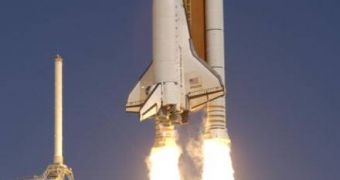The American space agency announced on Thursday that the risk of the Atlantis space shuttle to collide with a piece of space debris was well within its guidelines, and that the STS-125 mission to the Hubble Space telescope would, hopefully, go according to plan. In keeping with official NASA announcements, there is now a one in 221 chance of the shuttle being struck by a tiny piece of metal or other pieces of junk. Also, the seven-astronaut crew on the shuttle will be using the telescope as a shield, in order to minimize their chances of running into trouble.
The orbit that Hubble occupies is fairly crowded, and the craft is to remain near the telescope for some 11 days, during which time five spacewalks will be performed. In these orbits, micrometeorites are extremely dangerous, as are pieces of chipped paint and shreds of metal, which travel at several thousand miles per hour. Even a small piece of paint may have disastrous consequences if it impacts one of the astronauts' suits when performing a spacewalk. At those speeds, the otherwise small objects pass through virtually anything without breaking a sweat.
“That region of space is already supercritical. Given the amount of debris that was up there, the debris would double in 50 years, even if you didn't launch anything up there. What that says is that debris mitigation isn't enough. We're at the point where we have to do debris remediation and we don't know how to do that. You certainly can't say that anytime soon, the debris consequences are going to be so high that it's going to keep us out of space,” Union of Concerned Scientists (UCS) Space Security Specialist David Wright said, quoted by Wired.
Because of the dangerous nature of this mission, Atlantis will carry extra supplies to orbit. More food and water will be added to their inventory, and, in the event that something goes wrong, the crew will be able to survive on normal rations for up to 18 days. Also, on account of the fact that the International Space Station will be out of reach, the crew need to be very careful in conducting their investigations of the heat shield. This has become a standard protocol after the Columbia accident, and NASA is currently not taking any chances with the thin layer that protects the entire craft.

 14 DAY TRIAL //
14 DAY TRIAL //